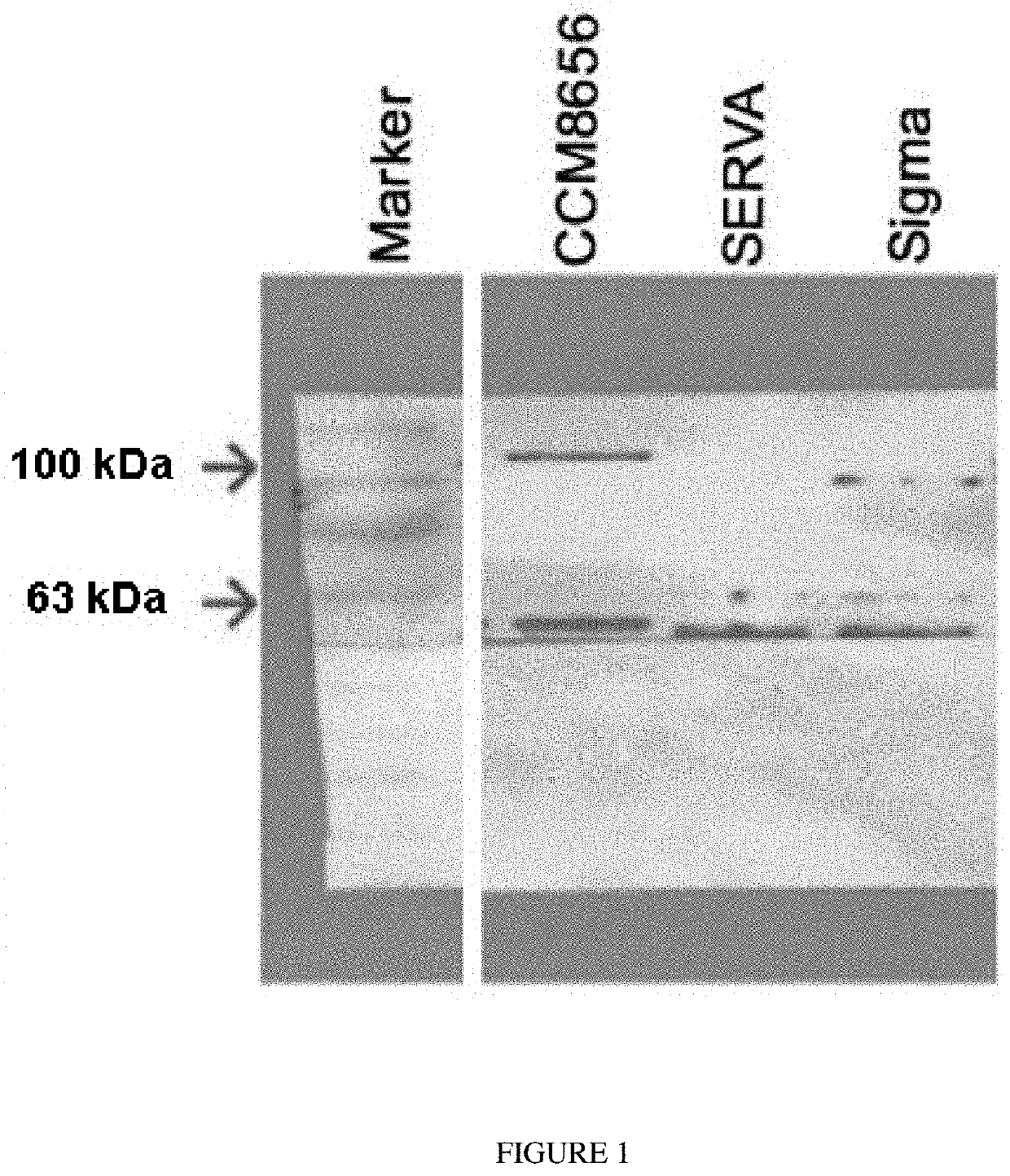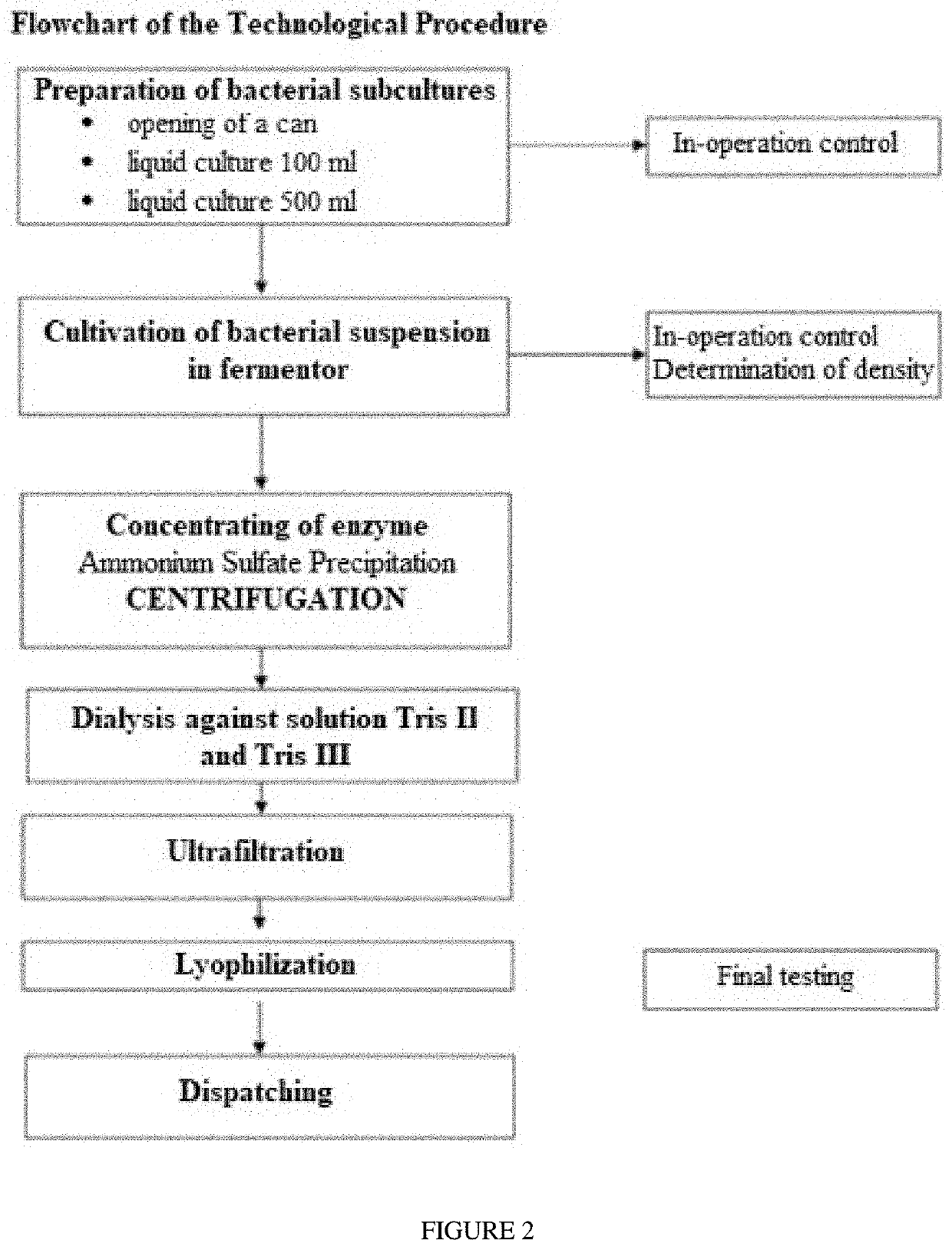Bacterial strain clostridium histolyticum and its use
a technology of clostridium histolyticum and clostridium hexavalent, which is applied in the direction of enzymes, pancreatic cells, biochemistry apparatus and processes, etc., can solve the problems of catalytic activity and the possibility of occurrence of lower molecular weight fragments, and achieve the effect of increasing its activity
- Summary
- Abstract
- Description
- Claims
- Application Information
AI Technical Summary
Benefits of technology
Problems solved by technology
Method used
Image
Examples
example 1
Opening and Inoculating of a Cab
[0021]Bacterial culture Clostridium histolyticum strain No. CCM 8656 is stored in a freezing medium at −80° C. or in a form of lyophilizate in a glass vial at 4° C. 100 μl of de-frost culture is inoculated to 100 ml of a liquid medium which is sterilized immediately before inoculation and then temperature-adjusted to a temperature of 37° C. The culture medium, suitable for cultivation of anaerobic bacteria is thus deaerated. The composition of tryptone medium suitable for sufficient production of collagenase is: (Tryptone 60 g / l, peptone 1.5 g / l, NaCl 2.5 g / l, glucose 1.25 g / l, Na2HPO4 3.4 g / l) pH 7.8, before inoculation, 100 μl of vitamin K of storage concentration 1% and 100 μl of L-cysteine of storage concentration 0.5 g / ml are added to the culturing medium. The culture is cultivated 24 hours at 37° C.±1° C. without agitation. After cultivation, purity of bacterial strains is verified through growth on solid media (anaerobic cultivation) and morpho...
example 2
[0030]Inoculation and culturing of bacterial strain Clostridium histolyticum CCM 8656 is the same as in Example 1. When culturing in the fermentor is completed, bacteria C. histolyticum is removed by centrifugation (7000×g) and precipitation of collagenase with ammonium sulphate is performed only in supernatant. Precipitate containing sulphate with precipitated protein is left to sediment for 4-6 days at 4° C. After dialysis against buffering solutions, Tris HCl buffers (the same buffers as in Example 1), then ultrafiltration follows again in cartridges millipore with “cut off” 50 kDa. When the protein is thickened, the sample is filled by 10 ml in vials and lyophilised.
example 3
[0031]Inoculation and culturing of bacterial strain Clostridium histolyticum CCM 8656 is the same as in Example 1. However, dialysis is followed by ultrafiltration through ultrafiltration cartridges, at first with “cut-off” 300 kDa for removal of ballast proteins of a large molecular weight. Thus, volume is increased because flow-through is maintained and then the solution is ultrafiltrated in a cartridge “cut off” 50 kDa for removal of smaller proteins and degraded parts. In the course of concentrating, Tris-HCl buffer (Tris 0.36 g / l, CaCl2 0.242 g / l, pH 7.5-8.5) is continuously added. When the protein is thickened, the sample is filled by 10 ml in vials and lyophilised.
PUM
| Property | Measurement | Unit |
|---|---|---|
| Temperature | aaaaa | aaaaa |
| Temperature | aaaaa | aaaaa |
| Atomic weight | aaaaa | aaaaa |
Abstract
Description
Claims
Application Information
 Login to View More
Login to View More - R&D
- Intellectual Property
- Life Sciences
- Materials
- Tech Scout
- Unparalleled Data Quality
- Higher Quality Content
- 60% Fewer Hallucinations
Browse by: Latest US Patents, China's latest patents, Technical Efficacy Thesaurus, Application Domain, Technology Topic, Popular Technical Reports.
© 2025 PatSnap. All rights reserved.Legal|Privacy policy|Modern Slavery Act Transparency Statement|Sitemap|About US| Contact US: help@patsnap.com


